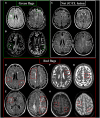Assessment of lesions on magnetic resonance imaging in multiple sclerosis: practical guidelines
- PMID: 31209474
- PMCID: PMC6598631
- DOI: 10.1093/brain/awz144
Assessment of lesions on magnetic resonance imaging in multiple sclerosis: practical guidelines
Abstract
MRI has improved the diagnostic work-up of multiple sclerosis, but inappropriate image interpretation and application of MRI diagnostic criteria contribute to misdiagnosis. Some diseases, now recognized as conditions distinct from multiple sclerosis, may satisfy the MRI criteria for multiple sclerosis (e.g. neuromyelitis optica spectrum disorders, Susac syndrome), thus making the diagnosis of multiple sclerosis more challenging, especially if biomarker testing (such as serum anti-AQP4 antibodies) is not informative. Improvements in MRI technology contribute and promise to better define the typical features of multiple sclerosis lesions (e.g. juxtacortical and periventricular location, cortical involvement). Greater understanding of some key aspects of multiple sclerosis pathobiology has allowed the identification of characteristics more specific to multiple sclerosis (e.g. central vein sign, subpial demyelination and lesional rims), which are not included in the current multiple sclerosis diagnostic criteria. In this review, we provide the clinicians and researchers with a practical guide to enhance the proper recognition of multiple sclerosis lesions, including a thorough definition and illustration of typical MRI features, as well as a discussion of red flags suggestive of alternative diagnoses. We also discuss the possible place of emerging qualitative features of lesions which may become important in the near future.
Keywords: diagnostic criteria; guidelines; lesions; magnetic resonance imaging; multiple sclerosis.
© The Author(s) (2019). Published by Oxford University Press on behalf of the Guarantors of Brain.
Figures





References
-
- Absinta M, Rocca MA, Colombo B, Copetti M, De Feo D, Falini A, et al.Patients with migraine do not have MRI-visible cortical lesions. J Neurol 2012; 259: 2695–8. - PubMed
Publication types
MeSH terms
Grants and funding
LinkOut - more resources
Full Text Sources
Medical

